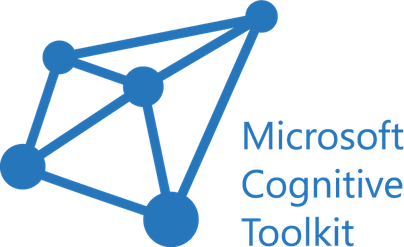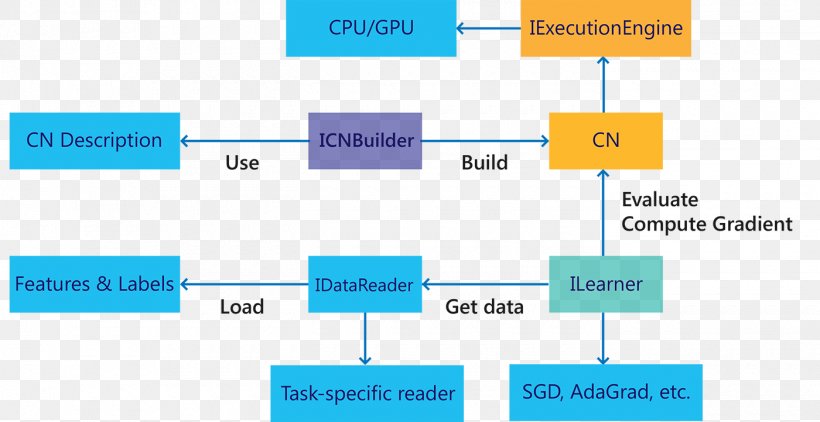
What is Microsoft Cognitive Toolkit?
Microsoft Cognitive Toolkit, previously known as CNTK and sometimes styled as The Microsoft Cognitive Toolkit
The Microsoft Cognitive Toolkit (CNTK) is an open-source toolkit for commercial-grade distributed deep learning. In this course, you’ll explore advanced techniques for working with Microsoft CNTK and identify which cases benefit most from MS CNTK. It describes neural networks as a series of computational steps via a directed graph. CNTK allows the user to easily realize and combine popular model types such as feed-forward DNNs, convolutional neural networks (CNNs) and recurrent neural networks (RNNs/LSTMs). CNTK implements stochastic gradient descent (SGD, error backpropagation) learning with automatic differentiation and parallelization across multiple GPUs and servers. You can implement many practical AI projects using Python and MS CNTK.
History
version 1.0 was released in 2016.It used a proprietary scripting language called BrainScript.It runs on both Windows and Linux systems but not directly on Mac OS.
Version 2.0 is a significant rewrite of the 1.0 Version and was released in June 2017.Its framework functions can be called using C++, Python. We can easily load our modules in C# or Java. BrainScript is also supported by Version 2.0.It also runs on both Windows (Win 8.1, Win 10, Server 2012 R2 and later) and Linux systems but not directly on Mac OS.
This version 2.7 is the last released version of the Microsoft Cognitive Toolkit. It has full support of ONNX 1.4. Following are some important highlights of this last released version of CNTK.
Feature of Microsoft Cognitive Toolkit
- Built-in components: CNTK has optimized built-in components that can handle multi-dimensional dense or sparse data from Python, C++ or BrainScript.
- Efficient use of resources: CNTK allows us to parallelize with high accuracy across multiple GPUs/machines via 1-bit SGD.
- Express your network easily: we can easily evaluate models with Python, C++, C# or BrainScript.
- It has fully optimized symbolic Recurrent Neural Network (RNN) loops.
- measuring model performance: CNTK provides various components to measure the performance of neural networks you build.
Written in Which Language
Microsoft Cognitive Toolkit are written in C++ for performance reasons, but v2.0 has a new Python language
Advantage of Microsoft Cognitive Toolkit
- It can be used to train deep learning models with state-of-the-art accuracy.
- It has a very powerful C++ API, and it also has both low-level and easy to use high-level Python APIs that are designed with a functional programming paradigm.
- It can be easily scaled over thousands of GPUs.
- It has C#/.NET/Java inference support that makes it easy to integrate CNTK evaluation into user applications.
- It can be easily extended from Python for layers and learners.
Built-in readers. CNTK has efficient built in data readers that also support distributed learning. - You would not be compromised in any way because the same toolkit is used by internal product groups at Microsoft.
Architecture of Microsoft Cognitive Toolkit

Alternative of Microsoft Cognitive Toolkit
- Keras
- TFlearn
- G2Deals
- Torch
- Clarifai
- NVIDIA
- DeepPy
- AWS Deep Learning AMIs
- Merlin
- SuperLearner
- Knet
Interview Question and Answer
Best Tutorials and guide
Best Courses and Insitute for learning
If you want certification course for such top course. So please visit “Devopsschool.com”. You will find more certification courses here.

I’m a DevOps/SRE/DevSecOps/Cloud Expert passionate about sharing knowledge and experiences. I have worked at Cotocus. I share tech blog at DevOps School, travel stories at Holiday Landmark, stock market tips at Stocks Mantra, health and fitness guidance at My Medic Plus, product reviews at TrueReviewNow , and SEO strategies at Wizbrand.
Do you want to learn Quantum Computing?
Please find my social handles as below;
Rajesh Kumar Personal Website
Rajesh Kumar at YOUTUBE
Rajesh Kumar at INSTAGRAM
Rajesh Kumar at X
Rajesh Kumar at FACEBOOK
Rajesh Kumar at LINKEDIN
Rajesh Kumar at WIZBRAND

